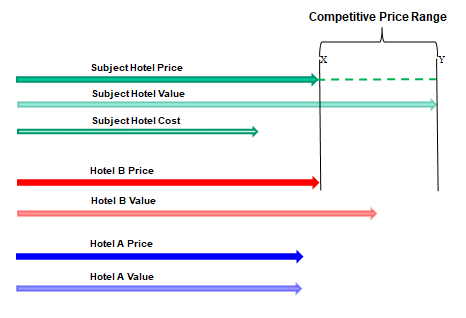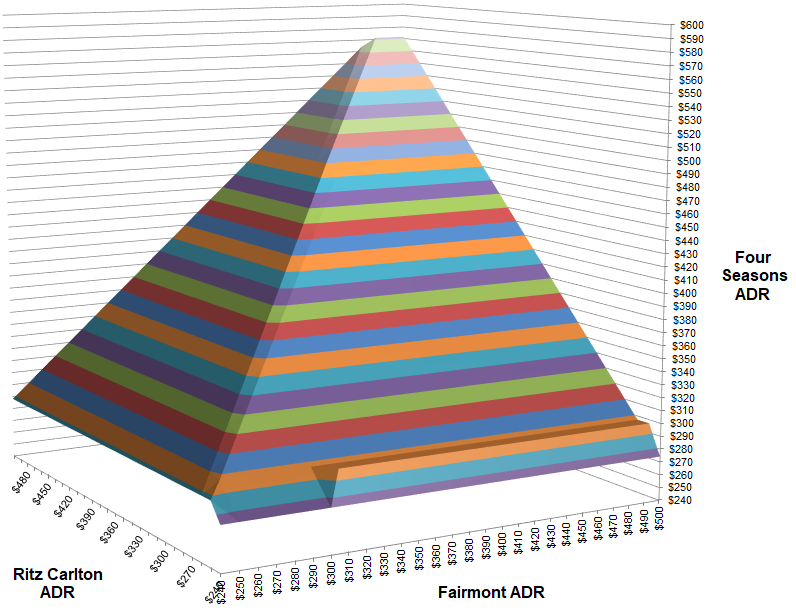We recently completed a value-based pricing assignment for a client that owns several luxury hotels in the US. The hotels are located in highly competitive markets which were classified as such by the use of the Herfindahl-Hirschman Index. Each of the hotels were considered the market leaders in their respective competitive sets. However, despite competitive occupancies, the owner wasn’t satisfied with the ADR achieved by the hotels, and believed the hotels were not achieving an adequate premium given the perceived value of a guest stay. The owner sought our assistance to develop value-based pricing models which could be used to set rates for the properties.
So what is value-based pricing when it comes to the lodging industry? Value-based pricing is a method of setting rates primarily on a guest’s perceived value of his or her stay at a hotel. The method stands in contrast to “cost-plus” and “competitor-based” pricing methods which are frequently used in the lodging sector today.
Hotels and resorts that provide unique or highly valuable features or services are better able to take advantage of value-based pricing methods compared to hotels which mainly sell commoditized features and services. See A Quick Guide to Value-Based Pricing in a recent Harvard Business Review.
Most hotels have never really figured out how much more or less than competitive hotels they should be charging. And if they have, they have probably arrived at some determination by using either flawed numerical analysis or a less than robust methodology. With a move from inventory-focused revenue management to customer-centric revenue management we can no longer take pricing and customer value as assumptions. Value must be measured and quantified before it can be correctly integrated into pricing & revenue management.
There is a need to identify and measure attributes that make the greatest contribution to customer value at two key points:
- when a guest is determining which hotel to patronize and
- during the guest’s ensuring stay
The assumption is that the guest is the only judge that really matters in establishing the value of a guest stay. The factors affecting guest’s decisions are better understood through a thorough and quantified analysis of customer needs and preferences. Value-based pricing enables users to achieve this objective through an integration of behavioral analysis and value engineering, which is much more powerful and precise than cost justification or investment analysis techniques.
Value-based pricing is normally implemented in three steps:
- Customer Driven Value Analysis
- Competitive Value Analysis, and
- Competitive Value Pricing.
The first step analyzes what customer want and establishes values of their wants. The next step compares how well different hotels satisfy guest requirements. For both steps we used the Analytic Hierarchy Process (AHP) to determine which specific hotel attributes were sources of value to guests. The technique was also used to rank the major attributes and derive a value index for each of the competitive hotels. The final step allows for the planning of pricing methodologies that take into account both competitive forces and also how well customers value the guest stay experience.
Decisions about pricing depend upon a number of considerations. Questions must be answered about how aggressive a hotel wants to be in gaining market share or maximizing profit. The measurement of competitive value from the second step allows for a better understanding of the price range available for a decision. The first step is to assign an arbitrary number to the price of the hotel offering the lowest value. In our example, we assume that Hotel A has a basic ratio of value to price of 1 and indicate it by drawing two vectors of the same length in the diagram below. Hotel B offered a price higher than Hotel A, but the higher price was more than offset by the higher value offered. When pricing for value, the issue is not to compete against the lowest price, but against the best value to price ratio.
The subject hotel started by placing on the diagram a vector indicating the relative value of its guest stays, and a vector equal to its price. The decision about pricing lies between two points. Point X indicates the same price as Hotel B. This price is acceptable for a very aggressive competitive posture, because the subject hotel would offer a much higher value or the same price. Price X would also offer the minimum profit for the subject hotel. Price Y assumes that the subject hotel will offer the same value/dollar as Hotel B. It maximizes profit, but it does not offer any specific competitive advantage to the subject hotel. The final decision was made for a price at a point between X and Y.
When pricing for value, compete against the best value-to-price ratio, not the lowest price!

Another way to view the value pricing decision is to set the lower and upper bands as follows. The lower bound, or aggressive pricing is determined either by the cost to provide the rooms and associated facilities (break-even price), or even lower if the hotel is willing to lose money in order to capture market share. The upper band is found with the following relationship:
P<=V/max(Vi/Pi) where:
P is the maximum ADR such that the hotel’s value to price value is at least as large as any of its competitors,
V is the hotel’s value,
Pi is competitor i’s ADR
Vi is competitor i’s value
A two way data table in excel was used to prepare the graph below which establishes the maximum ADR for the Four Seasons given the competitive ADRs for the Ritz Carlton and Fairmont hotels.
The Maximum Competitive Price for the Four Seasons Hotel

At the end of the assignment we were able to identify and implement a maximum justifiable ADR premium pricing strategy for the group of hotels. We were also able to identify and rank the attributes that were the most effective in creating value for guests in the individual hotels. This enabled a better allocation of resources in execution of value based pricing strategies – information collected was used to focus resources on the functionality of services and amenities that offered high value to guests.
The information obtained through the consistent use of the value-based pricing method can be used to discover which characteristics of the features and services of a hotel give the best value to guests and are more frequently requested.
The rate categories adopted for the hotel were able to accurately reflect the unique value of the hotels to different guest segments. Marketing and sales strategies were built around elements that offered the best value to customers. The hotels’ sale-forces were trained on how to sell hotel value and were appropriately compensated.